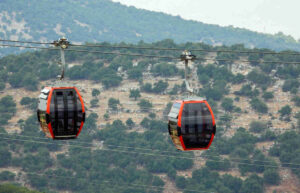Names say a lot about the territory to which they apply. And Jordan’s name, as well as related West Bank and Transjordan names, are no exception. In these lines we explain the meaning of each one, which will help you understand what they refer to and when they should be used.
The Jordan River, the reference of everything
The Jordan has always been a river of great importance: from prehistoric times to the present day, especially for its religious symbolism, exemplified by the rite of baptism carried out by John the Baptist, including that of Jesus, as we tell you in this other article.
Its particularity is that it does not flow into the open sea, but into the Dead Sea, which is not a sea as such, but an endorheic lake. It rises on Mount Hermon, in the Anti-Lebanon mountain range, progresses to the Sea of Galilee (which is also a freshwater lake), and from the time it leaves it until it reaches its mouth, it undergoes a process of salinization that makes it very unique.
So taking this special river as a reference, the surrounding region has been named throughout history, with the name of Jordan today, and with those of the West Bank and Transjordan in the past and also in our days. However, the use of the aforementioned names is relatively recent, since in previous centuries these terms did not exist or were not generalized.
Transjordan: “beyond the Jordan”
In the Western world, the term Transjordan has been used the earliest: at the time of the First Crusade (late eleventh century), Europe spoke of territories “beyond the Jordan” as Transjordan, by its French term (Outre-Jordain), since in fact it was the Franks who dominated the area immediately after.
Centuries later, despite the fact that the area fell back to the Arab side (those who had occupied it from the seventh century onwards), the use of this word was maintained to speak, in a generic way, to the territory that largely comprises today’s Jordan.
After the First World War, the political chessboard in the Middle East was strongly modified, mainly due to the fall of the Ottoman Empire, which had maintained control of this entire region. For this reason, from the 1920s, the newly created League of Nations (predecessor of the UN) assigned the United Kingdom the Protectorate of Palestine, which included the aforementioned Transjordan (then constituted as an autonomous emirate).
West Bank: “This Side of the Jordan”
The term West Bank began to be used in the mid-twentieth century, replacing the term Protectorate of Palestine. It literally means “on this side of the Jordan”, thus using a neo-Latinism, driven by the Western world (who see the region “on this side”, as opposed to the “beyond” of the river). In fact, an Arabic term also uses this idea (الضفة الغربية aḍ-Ḍaffah l-Ġarbiyyah), also adapted to English as “west bank”. From the Israeli point of view, the term Judea and Samaria is used, in relation to historical demarcations that date back to biblical times.
However, the creation of the state of Israel and the outbreak of the various wars against the Arab states changed everything, reducing the West Bank to a smaller strip of territory, albeit annexed to the west bank of the Jordan River.
Jordan: the current term
With the creation of the independent state of Jordan, in the form of a Hashemite kingdom, it was decided to use the generic term of Jordan although, effectively, the entire territory of the country is “beyond the Jordan”, in what was formerly known as Transjordan.
And this is still the case today and, despite the fact that there are no territorial claims to the West Bank, a strong cultural link with the area is still maintained, as evidenced, for example, by the fact that it is the Kingdom of Jordan that holds the interior custody of the temples on the Esplanade of the Mosques, in East Jerusalem (generally considered part of the West Bank).



